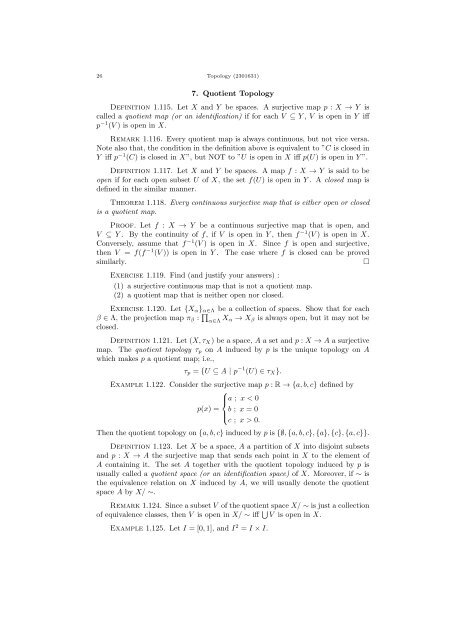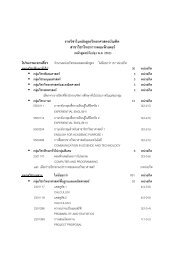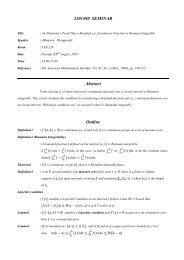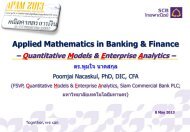Lecture Notes Topology (2301631) Phichet Chaoha Department of ...
Lecture Notes Topology (2301631) Phichet Chaoha Department of ...
Lecture Notes Topology (2301631) Phichet Chaoha Department of ...
You also want an ePaper? Increase the reach of your titles
YUMPU automatically turns print PDFs into web optimized ePapers that Google loves.
26 <strong>Topology</strong> (<strong>2301631</strong>)<br />
7. Quotient <strong>Topology</strong><br />
Definition 1.115. Let X and Y be spaces. A surjective map p : X → Y is<br />
called a quotient map (or an identification) if for each V ⊆ Y , V is open in Y iff<br />
p −1 (V ) is open in X.<br />
Remark 1.116. Every quotient map is always continuous, but not vice versa.<br />
Note also that, the condition in the definition above is equivalent to ”C is closed in<br />
Y iff p −1 (C) is closed in X”, but NOT to ”U is open in X iff p(U) is open in Y ”.<br />
Definition 1.117. Let X and Y be spaces. A map f : X → Y is said to be<br />
open if for each open subset U <strong>of</strong> X, the set f(U) is open in Y . A closed map is<br />
defined in the similar manner.<br />
Theorem 1.118. Every continuous surjective map that is either open or closed<br />
is a quotient map.<br />
Pro<strong>of</strong>. Let f : X → Y be a continuous surjective map that is open, and<br />
V ⊆ Y . By the continuity <strong>of</strong> f, if V is open in Y , then f −1 (V ) is open in X.<br />
Conversely, assume that f −1 (V ) is open in X. Since f is open and surjective,<br />
then V = f(f −1 (V )) is open in Y . The case where f is closed can be proved<br />
similarly.<br />
□<br />
Exercise 1.119. Find (and justify your answers) :<br />
(1) a surjective continuous map that is not a quotient map.<br />
(2) a quotient map that is neither open nor closed.<br />
Exercise 1.120. Let {X α } α∈Λ be a collection <strong>of</strong> spaces. Show that for each<br />
β ∈ Λ, the projection map π β : ∏ α∈Λ X α → X β is always open, but it may not be<br />
closed.<br />
Definition 1.121. Let (X, τ X ) be a space, A a set and p : X → A a surjective<br />
map. The quotient topology τ p on A induced by p is the unique topology on A<br />
which makes p a quotient map; i.e.,<br />
τ p = {U ⊆ A | p −1 (U) ∈ τ X }.<br />
Example 1.122. Consider the surjective map p : R → {a, b, c} defined by<br />
⎧<br />
⎪⎨ a ; x < 0<br />
p(x) = b ; x = 0<br />
⎪⎩<br />
c ; x > 0.<br />
Then the quotient topology on {a, b, c} induced by p is {∅, {a, b, c}, {a}, {c}, {a, c}}.<br />
Definition 1.123. Let X be a space, A a partition <strong>of</strong> X into disjoint subsets<br />
and p : X → A the surjective map that sends each point in X to the element <strong>of</strong><br />
A containing it. The set A together with the quotient topology induced by p is<br />
usually called a quotient space (or an identification space) <strong>of</strong> X. Moreover, if ∼ is<br />
the equivalence relation on X induced by A, we will usually denote the quotient<br />
space A by X/ ∼.<br />
Remark 1.124. Since a subset V <strong>of</strong> the quotient space X/ ∼ is just a collection<br />
<strong>of</strong> equivalence classes, then V is open in X/ ∼ iff ∪ V is open in X.<br />
Example 1.125. Let I = [0, 1], and I 2 = I × I.





